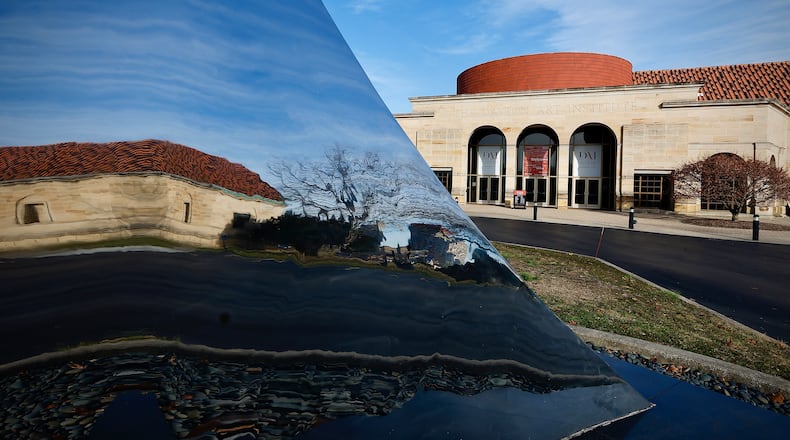The investigation found the museum has been in the red for five years, it recorded several millions of dollars in losses those years, its board of trustees gave two of its executives salary increases of up to 80% the year after it saw a $2 million loss in revenue and it reported different revenue numbers on its community report and its federal 990 tax form in at least two recent years.
The lengthy email to DAI members provided additional explanation on executives' salaries and DAI operations.
The Dayton Daily News reached out to officers on the Board of Trustees, who declined to comment and referred this news outlet to the institute.
“Operating the historic building and aligned programming is simply not sustainable for the future without the support of the individuals and corporations in the community,” said Daniel Davis, chair of the Dayton Art Institute’s Board of Trustees, in the letter sent to DAI members.
Museum executives told the Dayton Daily News the 2025 budget is $4.5 million less than its 2024 budget after several employee and expense cuts.
Director to see salary cut 20%
One area the letter immediately addressed was the compensation for the top earners of the art institute, which saw significant increases during the COVID-19 pandemic.
Salaries for Michael Roediger, director and CEO of the Dayton Art Institute, and Jerry Smith, chief curator, increased by 71% and 93%, respectively, from 2019 to 2023, according to IRS 990 tax forms.
Credit: Lisa Powell
Credit: Lisa Powell
Those increases were part of an effort to offer Roediger and Smith competitive salaries, Mike Griest, director of external affairs for the Dayton Art Institute, previously told Dayton Daily News.
“Prior to the pandemic, it was identified that many museum staff were being compensated below the median set by the Association of Art Museum Directors for their position,” said Davis, referencing the market research that was done to see what people in similar positions are paid.
The Board of Trustees decided “to review and invest in” its workforce, as the board said it was a strategic move to retain staff.
“The Board of Trustees was keenly aware that pay rates for these positions put them at risk of turnover compared to institutions with higher compensation structures. Pronounced investment was required to ensure position stability and retention for the museum,” Davis said.
Davis said the institute plans to reduce the director’s salary by 20% among reductions to other positions across the organization.
“Making reductions is always a difficult decision, as the museum staff are a dedicated team of professionals who deserve to be paid a quality standard of living as they fulfill our mission,” Davis said.
Roediger’s salary in 2023 was reported as $243,742, so 20% would be approximately $48,748.
Audited figures to be used for annual reports
Another area the letter addressed was the annual community report the museum releases to the public.
A Dayton Daily News examination of the publicly available tax forms filed by the nonprofit showed the museum reported revenues and expenses to the IRS different than those presented to the public in at least two community reports since 2020.
Though the figures included in the community reports indicated the funds listed were unaudited, a 2022 report indicated the operating revenue was $3.3 million more than what was reported in the institute’s 990 tax form.
The differences were due to the community reports being done before a full audit was completed, the institute previously said. The employee who compiled those figures no longer works for the DAI. When asked for additional information, the institute said its policy is not to discuss the performance records of any current or former employee.
To resolve future discrepancies between the institute’s community reports and its tax forms, the institute is moving its annual meeting until after the completion of its regular audit, Davis said.
“We understand that the unaudited numbers that have been used in the past are causing confusion, and we are committed to resolving that for the future,” Davis said.
DAI not ‘flush with assets’
The Dayton Art Institute’s works of art are cultural assets, but not financial ones, the board said, meaning the museum’s collection cannot be sold for capital.
“Often people assume an organization like the DAI is flush with assets because of the impressive building and beautiful art within its walls,” Davis said.
Regulations in the art industry prohibit museums from selling works of art for general operating or capital improvements, he said in the letter.
The rising costs of goods and services have impacted the institute just like it has impacted other nonprofits and organizations, the letter said.
“While the Dayton Art Institute invested heavily since the pandemic in positions and programming, revenues did not follow at the same rate. Decreased income forced the museum to significantly reduce spending to maintain a balanced budget,” Davis said.
This led the institute to make a handful of layoffs and readjust internal departments.
The board is regularly updated on the finances and budgets for the institute, Roediger said when reached for further comment.
“The Board of Trustees is provided with a financial report prior to each meeting and continue to work alongside DAI leadership to create a sustainable financial plan for the future. We are fortunate to have a supportive and dedicated Board of Trustees,” Roediger said.
The institute’s 2025 budget is complete and has been approved by its board of trustees, Roediger said.
“We continue to actively seek additional income and costs savings,” Roediger said.
Reassurances for the future
The Dayton Art Institute’s board reiterated that programming and services for patrons will remain intact, saying those were “the anchor of reduction decisions.”
“In a community with no oceans or mountains, a rich and diverse arts scene is crucial for economic vitality,” Davis said.
The board reiterated it does not receive regular funding through a tax levy, instead relying on donations, investment income, income from events and admissions and competitive grants from organizations like Culture Works and the Ohio Arts Council.
More funding is needed, though, as it works to make it to balanced budget. The institute said it needs to expand its donor base.
“We have been contributing to the economic success of the region for decades, but we need your support more than ever,” he said.
About the Author





